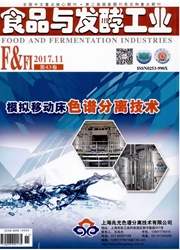

 中文摘要:
中文摘要:
以金黄色葡萄球菌、铜绿假单胞菌和大肠杆菌为试验菌,采用涂布法确定蓝莓叶多酚的抑菌浓度及牛津杯法明确蓝莓叶多酚p H值对抑菌活性的影响。通过测定蓝莓叶多酚与3种试验菌作用前后的生长曲线、菌液的电导率值、260 nm处的吸光值和观察细胞形态变化,初步阐明蓝莓叶多酚对3种试验菌的抑菌机理。结果表明,蓝莓叶多酚对金黄色葡萄球菌、铜绿假单胞菌、大肠杆菌都有较强的抑菌活性,最低抑菌浓度分别为0.062 5%、0.062 5%和0.125%,在p H7.0~8.0抑菌性较强。经蓝莓叶多酚处理后,3种试验菌生长缓慢,菌液电导率值、260 nm处的吸光值均增大;蓝莓叶多酚作用于菌体细胞后,菌体细胞出现断裂,细胞壁凹陷等现象,表明蓝莓叶多酚可使细胞膜通透性增加,破坏细胞膜完整性,使细胞内容物外泄。
 英文摘要:
英文摘要:
The MIC of blueberry leaf polyphenol was determined through Spread Plate and the effects of blueberry leaf polyphenol pH vaule on its antimicrobial actions against Staphylococcus aureus,Pseudomonas aeruginosa and E.coli were investigated through Oxford cup method.Based on the measurement of the change of growth curve,conductivity value,and OD260 value as well as observation on cells under scanning electron microscopy,the antimicrobial mechanisms of blueberry leaf polyphenol was confirmed.The results showed that there was antimicrobial action against E.coli,Staphylococcus aureus and Pseudomonas aeruginosa.The MIC were 0.125%,0.0625%,0.0625%,respectively.Antimicrobial action was higher within pH value 7.0 ~ 8.0.After processing with blueberry leaf polyphenol,the test bacteria grew slowly,and conductivity value and OD260 value could be increased.In addition,bacterial cells appeared rupture and cell wall sag.These phenomena indicated that Blueberry leaf polyphenol could increase cell membrane permeability,destroy cell membrane integrity and leak cytoplasm.
 同期刊论文项目
同期刊论文项目
 同项目期刊论文
同项目期刊论文
 期刊信息
期刊信息
